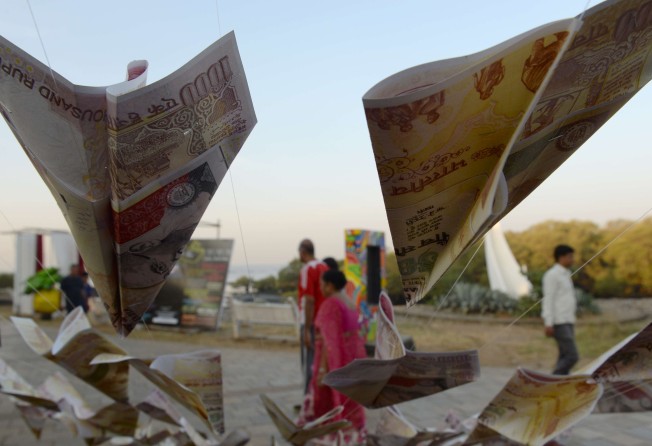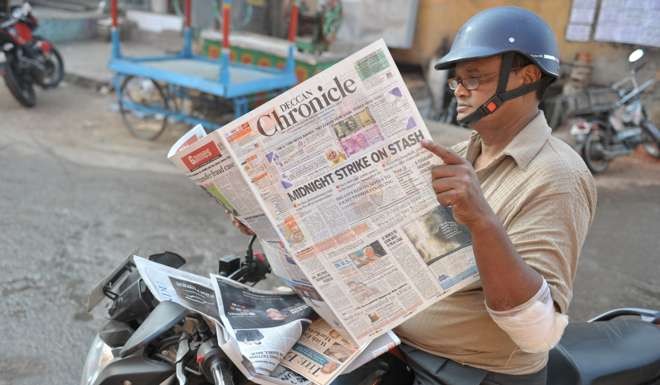
India’s note ban: what Modi can really achieve
The Indian prime minister’s demonetisation of 500 and 1,000 rupee notes has come in for heavy criticism – but if he succeeds, a lasting legacy beckons

Across the road from Mumbai’s Dharavi, one of the world’s biggest slums, Altaf Sheikh is braving the afternoon blaze and the stench of garbage that hangs over the sprawling mangrove dump where many of the city’s sewers drain, diligently separating the copper from the tangle of wires he has bought this morning.
For this back-breaking work, he used to make 700-800 rupees a day by selling back the copper to a trader in Dharavi, barely enough to support his family and survive in India’s most expensive city. These days he isn’t even hitting half of that.
Two months ago, Indian Prime Minister Narendra Modi announced the withdrawal of Rs500 and Rs1,000 banknotes as he declared war on “black money”, as unaccounted wealth is called in India.

These high-denomination notes, he said, needed to be flushed out of the system to end the country’s endemic corruption and widespread counterfeiting, which aids terrorism. But as these notes constitute 86 per cent of the cash in circulation and a fraction of the new notes needed to replace them were printed, the disruption has been painful, causing widespread inconvenience and paralysing large segments of India’s mostly cash-driven economy.
Sheikh’s world has been turned upside down. “I’ve never had it this bad. The traders are saying they can’t pay as they don’t have enough money and are demanding hefty discounts. I have a bank account but they are refusing to pay by cheque. And even if they do, I’ll have to skip a day’s work to get that money out of the bank,” says Sheikh, alluding to the long queues at banks and ATMs.

His hand-to-mouth existence naturally precludes that option. Scrap prices, he says, have crashed as a result. Copper scrap now fetches him Rs260 a kg compared to Rs380 before the cash ban. Brass scrap has plummeted from Rs250 to Rs160 and iron scrap from Rs20 to just Rs4.
Further up the value chain, and deeper into Dharavi’s labyrinthine heart, Hanumanthi Devi and her two employees are busy sorting scrap into separate containers at her 10ft by 3ft shop.
The gritty 60-year-old, who started out as a ragpicker 35 years ago and graduated to trading along the way, is among those who buys scrap from Sheikh. Asked why she isn’t paying Sheikh the old rates, she in turn blames her client, a bigger vendor. He doesn’t have enough cash and won’t write cheques, she says. Why not? “He would have to pay tax.”
That is exactly why demonetisation is such a great idea, says Deepak Morada, vice-president at conglomerate Larsen & Toubro, as we chase fried prawn with beer at a Tony’s Seafood Restaurant on a different planet 15km from Dharavi.

The restaurant is among the scores of exclusive dining joints in this downtown neighbourhood dotted with colonial-era buildings, including a synagogue.
“All these small businesses in Dharavi, for example. They make enough to pay taxes. Why shouldn’t they pay their fair share and follow ethical employment norms? Imagine what that can do for India,” he says.
“India has a very large population of self-employed professionals, and small- and medium-sized businesses who clearly have taxable income but have never ever paid taxes. To get them to change their mindsets and start paying tax will not be easy; they will need to be forced to do so through mechanisms that will make evasion difficult and expensive.”
Morada’s excitement about the immense tax collection possibilities as a result of Modi’s cashless drive is well founded. He is channelling economists’ estimates that the Indian government gets less than a third of the tax revenue due to it because the informal sector accounts for about 40 per cent of the economy. Only 1 per cent of the country’s 1.3 billion people pay direct taxes, and the Modi government has been trying to find ways to widen the tax base to improve public finances and raise state capacity.

One major reason for the low direct taxes is that the politically significant agriculture sector, which employs 54 per cent of Indian workers, has traditionally been kept out of the tax net. But as the importance of agriculture has declined in India’s economy, from 51 per cent of GDP in 1950 to about 18 per cent at present, policymakers have been looking to the fast-growing services (which now contributes 57 per cent of GDP) and industrial sectors (25 per cent) to widen the tax base. That way, the cashless drive dovetails neatly into the Modi government’s thrust of increasing tax collection.
Finance Minister Arun Jaitley last month announced a net increase in collection of all taxes as proof of the success of demonetisation. “The impact of demonetisation on tax revenue and collection is already visible. There has been a 26.2 per cent increase in central indirect tax collection till November 30,” he said at a press conference, adding that till December 19, direct tax collection increased 14.4 per cent compared with a growth rate of only 8.3 per cent previous year.

As the government is seeking to levy a 50 per cent tax on those who declare unaccounted wealth and force them to park another 25 per cent of their disclosed amount in interest-free deposits for four years, government coffers may get a short-term boost, helping it in executing major social development projects. But Modi has been labouring the point that the currency ban is aimed at long-term structural changes, not short-term gains. Bringing a chunk of the Indian economy out of the shadows could indeed be the lasting legacy of his ban decision, but his critics are implacable.
Nobel laureate Amartya Sen calls the move to annul a legal tender a “despotic action” striking “at the root of economy based on trust”. Manmohan Singh, the former prime minister, has termed it “organised loot and legalised plunder”. Steve Forbes sees it as “sickening and immoral” and calls India the “most extreme and destructive example of the anti-cash fad currently sweeping governments and the economics profession”.
But this fad, argue economists like Jagdish Bhagwati of Columbia University, is what will deliver “long-
term beneficial impact” despite the “hardships” it has caused, and hails Modi for showing the courage and political will to tackle India’s black-money problem.
“Inevitably, the Indian economy will move towards digitisation of economic transactions, with cash currency playing a relatively minor role. The argument that the policy is anti-poor is suspect as a significant fraction of the taxes and surcharges that will be collected from the reform initiative is to be allocated to social programmes,” he wrote in a recent blog.

Apart from a wider tax base, demonetisation is expected to lead to greater bank deposits, allowing banks to cut interest rates, boosting investment and economic growth. Several bankers in Mumbai told This Week in Asia on the condition of anonymity that the government had been leaning on them to bring down lending rates.
Flush with funds, several state-owned banks, led by the country’s largest lender, State Bank of India, began the new year by cutting the benchmark interest rate by 0.9 per cent, effective from January 1, taking the cue from Modi’s address on New Year’s Eve to the nation on demonetisation.
“While respecting the autonomy of the banks, I appeal to them to move beyond their traditional priorities, and keep the poor, the lower-middle class, and the middle class at the focus of their activities,” he had said in his year-end address, timed to coincide with the 50-day window he had asked from the people to restore normality following the note ban. ■